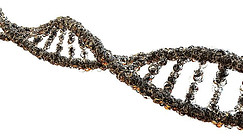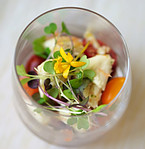The #1 most essential item you need to grow microgreens is SEEDS.
You do not need a special kind of microgreen seeds to grow microgreens. You can use the same seeds that are used for growing vegetables in your garden. However, when grown with the intention of harvesting as microgreens, seeds are generally sown much more densely, and therefore a greater quantity is sometimes needed than is included in a typical garden seed packet. Also, just as with outdoor gardening, you have the option to choose seeds that are untreated, non-GMO and/or certified organic.
Quantity
The first thing to consider when sourcing your seeds is the quantity you are going to need. When growing seedlings to harvest as microgreens, seeds are sown more densely than when sowing with the intent to grow to maturity. The amount of seed needed is going to depends on the size of container being used.
If you are growing microgreens in 4″ (10 cm) square pots, for example, a standard-sized seed packet is likely to be just the right amount. However, if you are using seed trays, (sometimes called 1020 flats) then it will probably be more economical to find a seed retailer that has bulk quantities available.
Treated or Untreated?
DO NOT USE TREATED SEEDS FOR GROWING MICROGREENS!
Treated seeds almost always have hazardous chemicals on them.
The Wikipedia article on seed treatment states:
In agriculture and horticulture, seed treatment or seed dressing is a chemical, typically antimicrobial or fungicidal, with which seeds are treated (or “dressed”) prior to planting. Less frequently, insecticides are added. Seed treatments can be an environmentally more friendly way of using pesticides as the amounts used can be very small. It is usual to add colour to make treated seed less attractive to birds, and easier to see and clean up in the case of an accidental spillage. Specialist machinery is required to safely and efficiently apply the chemical to the seed.
Lizabeth Stahl and Bruce Potter, at the University of Minnesota Extension wrote in a blog post:
“DO NOT allow treated seed to enter the food or feed chain. Treated seed is not to be used for food, feed or oil processing, and care must be taken to not contaminate grain going into the food or feed market… For more information on the safe handling of treated seed, check out the U of MN fact sheet on this topic at: https://z.umn.edu/shtseed “
Obviously we don’t eat the seeds when we grow microgreens, but seeds which are coated in chemicals that are so hazardous that personal protective equipment is required to handle them are not proven safe to use for a crop that is harvested within a week or two of planting.
GMO or Non-GMO?
GMO is an acronym for Genetically Modified Organism. According to the Non-GMO Project, a GMO
“is a plant, animal, microorganism or other organism whose genetic makeup has been modified in a laboratory using genetic engineering or transgenic technology. This creates combinations of plant, animal, bacterial and virus genes that do not occur in nature or through traditional crossbreeding methods.”

There is no scientific consensus on the safety of consuming GMOs as food.
Personally, I only use non-GMO seeds for growing microgreens as well as in my outdoor vegetable garden.
Organic?
 According to the United States Department of Agriculture,
According to the United States Department of Agriculture,
“‘Organic’ is a labeling term that indicates that the food or other agricultural product has been produced through approved methods. The organic standards describe the specific requirements that must be verified by a USDA-accredited certifying agent before products can be labeled USDA organic. Access the full set of resources that make up the USDA organic standards.”
Certified Organic seeds come from plants that have been grown in compliance with organic standards. Conversely, if you want your end crop of microgreens to be certifiable as ‘Organic’ it must be grown from organic seeds (when available.)
However, organic seeds are considerably more expensive, as is the process to have your end product certified as ‘Organic.’ Additionally, not all varieties of seeds are going to have organic versions available. In my opinion, if you are not planning to market your microgreens as ‘Certified Organic,’ and you do not have an environmental illness requiring you to consume only organic foods, then it is not absolutely necessary to only use organic microgreen seeds.
Germination Rate
 Germination rate is an expression used to indicate how many of the planted seeds actually sprouted and grew into plants. (If I plant 100 seeds and 95 of them produce seedlings, that is a germination rate of 95%.) Customer reviews will often mention the germination rate when reviewing the seeds that have been purchased from a retailer. (The best growers keep records, and germination rate is one of the factors that is great to include.) It doesn’t matter how many seeds you plant if they don’t grow.
Germination rate is an expression used to indicate how many of the planted seeds actually sprouted and grew into plants. (If I plant 100 seeds and 95 of them produce seedlings, that is a germination rate of 95%.) Customer reviews will often mention the germination rate when reviewing the seeds that have been purchased from a retailer. (The best growers keep records, and germination rate is one of the factors that is great to include.) It doesn’t matter how many seeds you plant if they don’t grow.
High quality seeds should all germinate, provided their requirements (temperature, moisture, etc) have been met.
It’s pretty much an all or nothing game: If you’ve followed all the instructions, you should have nearly all of your seeds germinate. If you forgot to keep them watered and they all dried out, or you left them in direct sunlight under a humidity dome and they reached a temperature near the boiling point of water, then expect zero germination. If you follow all the instructions and only half of the seeds germinate, maybe consider getting your seeds from a different source.
Remember – Microgreens are food.
 A prepared dish is made up of its component ingredients. The higher quality the ingredients, the higher quality the final dish will be. The #1 most important “ingredient” in growing microgreens is seeds. The higher quality of seeds you use, the higher quality your finished microgreens will be. By choosing untreated, non-GMO seeds from a reputable retailer that offers bulk quantities of microgreen seeds, you set yourself up for the best possible finished crop.
A prepared dish is made up of its component ingredients. The higher quality the ingredients, the higher quality the final dish will be. The #1 most important “ingredient” in growing microgreens is seeds. The higher quality of seeds you use, the higher quality your finished microgreens will be. By choosing untreated, non-GMO seeds from a reputable retailer that offers bulk quantities of microgreen seeds, you set yourself up for the best possible finished crop.
***Do you have any experience or insight about microgreen seeds? Please share in the Comments section below.***

wow, awesome information in this post. I learned what GMO stands for lol. I have always wanted to grow a garden and I still have no idea where to start but this will give me some good insight on where to begin.
Awesome post!!
Thank you, Tamika. Just start. You can learn as you go. It is such a wonderful feeling to eat (and to share) food that you have grown yourself. You can start small – a single pot on your windowsill, patio or balcony, but just start!
Wonderful article with lots of interesting content. I try and eat non-GMO and organic as much as possible. However, I do not have a green thumb. I did find this info very interesting though. Thank you for sharing.
Thank you, Annette. In all honesty, my thumb is not particularly green either. I’ve had decent success with microgreens because they are harvested so soon, before things can go too terribly wrong. (Not that I haven’t had some failures as well. I just call it “plant school” and move on!)
Great article with lots of detailed, in depth and well written content! There is very interesting information in this article! Thank you for writing and sharing this article!
Thank you, Timothy. I hope the next time you see some microgreens, you think, “Hmmm…maybe I’ll try them.”
I love this article, this has answered certain questions I had. I most likely will come back here for more understaning. Thank You Susan..great work
Thank you, Ebie. I hope you do come back!
I remember when I was a kid, this goes back a ways, organic seeds were so cheap, and the veggies we grew were all organic and we used the seeds from the vegetables to replant. Now I have heard that GMO’s are taking over the market with Monsonto trying his best to monopolize the market, so organic seeds are now pretty pricey.
Thanks for all this good information, and a reference to go to for growing veggies.
Thank you, Audrey. Yes, times have changed. But there is a growing local food movement (pardon the pun) and every home grown plant adds to it. Happy growing!
hey, thx for the information ,I ve been searching for it 3 days ago ahaha but I have one more question : can we remove the chemical substance by rinsing the seeds in water and the planting them because I can not get the one with non-chemicals
it can lower the toxicity of the seed so we can eat them after planting ?
plz contact me to know what can I do ,I just stared growing microgreens :)))))))))))
Well that’s a very interesting question, Georges. I have never tried removing the coating from treated seeds. The coating substance is usually very brightly colored, so you might be able to tell once it is gone, but I don’t know if there would still be a residue present. For your personal safety (and my personal liability, lol) I would not advise you to eat microgreens from such seeds. Depending on type, you might be able to grow the plants out to maturity and let them produce new, untreated seeds for you. But I do have some treated flower seeds on hand. Just for fun I may experiment with washing the coating off to see what happens.